Adaptation of a Baby Seat for Attachment to a Wheelchair
ABSTRACT
A client in a power wheelchair came to the Center for Assistive Technology (CAT) in search of a device to add a baby carrier to her wheelchair. The project design included adaptation of a baby bike seat and creation of mounting hardware in order to interface the bike seat to the wheelchair frame. The design process in this project was driven by the client's needs and preferences. The final product has a 20 degree tilting feature, is able to spin 360 degrees, is lightweight, and can easily detach from the wheelchair.
KEYWORDS
Wheelchair, baby seat, assistive technology, rehabilitation engineering
BACKGROUND
The client for this project first came to the Center for Assistive Technology for a wheelchair assessment. She has congenital bilateral high above the knee amputations. She received a Pride Jazzy 1122 (1) power wheelchair when manual wheelchair propulsion became a problem due to bilateral carpal tunnel syndrome. After becoming pregnant, she faced several problems concerning her capacity to look after and transport her new baby. The amputations result in a high postural center of gravity and limited ability to keep herself upright without the use of her arms. Driving with one arm and holding a child in the other arm would leave her at a high risk for falling forward and out of the wheelchair seat. She was unable to find a commercial product that would attach to her wheelchair and provide a way to carry the baby. The client came to the CAT looking for assistance with her specialized problem.
The client wanted a carrier that was located close to the front of her wheelchair seat so that she would not have to lean far from center, thus preventing her from losing her balance and tipping over. The carrier design would also need to be lightweight in order for her to be able to lift the seat without being in an unstable position. She also wanted all of the parts of the carrier to be removable from her wheelchair.
A first generation baby carrier was made for the client using an infant car seat with a carry handle and mounting hardware on the wheelchair. However, the weight limit of the car seat was 20 pounds and the baby was quickly outgrowing the original carrier. It was suggested that a baby bike seat be used in a second version and the client then purchased a seat to be adapted to attach to her power wheelchair.
PROBLEM STATEMENT
The goal of this project was to design a means to attach the new baby bike seat to the wheelchair while meeting all of the needs of our client. The attachment method should be sturdy and strong, with little play in the system. The bike seat components should be lightweight so the client can pick the seat up from a stable, seated position in her wheelchair. The client wanted the bike seat to rotate 360 degrees, especially so that the baby could face forward. She also wanted the seat to tilt back so the baby could rest in the seat. The client needed the seat to be easily removable from the mounting hardware on the wheelchair so that she would be able to remove it herself. In addition, the mounting hardware must detach from the wheelchair without difficulty.
DESIGN AND DEVELOPMENT
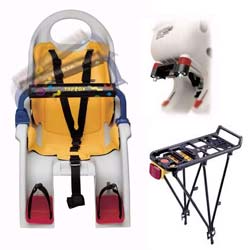 |
The design approach was driven by individual client needs and preferences. She was consulted several times during the process where available design options were shared with her to obtain her input and determine if they would meet her needs. The client purchased a Topeak BabySeat (2) that is safety rated for a baby up to 40 pounds. The top four inches of the bike seat were cut off allowing for a clearer driving view over the seat for the client. This modification did not affect the integrity of the molded bike seat.
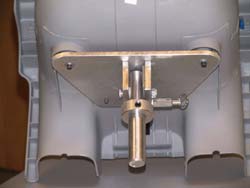 |
The project began by designing a bracket on the bottom of the bike seat. In the rear of the bike seat bottom there were two aluminum posts that would be used to attach the bike seat to a rack on the adult bike. The two posts were shortened and a hole was drilled and threaded into each so that a bolt could be screwed into the posts for support. Two additional holes were drilled through the buttock portion of the plastic molded bike seat. A 1/4-inch thick aluminum plate was fashioned around the four holes and secured to the seat with four bolts. Aluminum was chosen because it is a strong, yet lightweight material. Two aluminum blocks were perpendicularly bolted to the bottom of the plate behind the approximate line of the center of mass of the baby in the seat so that the seat would not be prone to tilting backwards when the locking pin is released. In order for the seat to spin 360 degrees, a 1-inch diameter aluminum post was used to interface with the mounting hardware on the wheelchair. The round post was attached in between the two blocks with a 3/8-inch shoulder bolt. The seat could then tilt forwards and backwards about this bolt when the post is held in the mounting hardware. A spring loaded pull pin was used to lock the seat into a 0 degree and a 20 degree tilted position. The pull pin was screwed into the left block and the inner pin extended into one of two holes in the post to lock the tilt angle of the seat. A collar was clamped on the round post, leaving 3 ½-inches to insert into the top of the mounting hardware. The length of 3 ½-inches was chosen to minimize adding weight while still having enough material in the mounting hardware for stability of the seat.
 |
In order to attach the seat to the wheelchair, mounting hardware was designed to fit into a foot platform receptacle already available on the client's Pride Jazzy 1122 power wheelchair. A steel block was machined to fit into the receptacle, including a slot lengthwise in the block to accommodate a bolt through the receptacle that supports the footplate. The front (forward facing) side of the block was tapered at a 5-degree angle to allow the seat post to remain perpendicular to the ground. A horizontal rectangular tube 7 7/8-inch in length was welded to the receptacle block. This length was calculated to put the bike seat as close to the wheelchair as possible, but just far enough away from the wheelchair cushion so that it is not obstructed from turning. A 1 ¼-inch diameter round tube was then welded in a vertical position at the end of the horizontal tube. The round tube was 4 3/4 inch in length, which put the bike seat level with the wheelchair cushion. A delrin plastic bushing was turned and press fit into the top of the vertical round tube. The round aluminum post from the seat bracket fits into this bushing, providing a smooth surface for rotation of the seat.
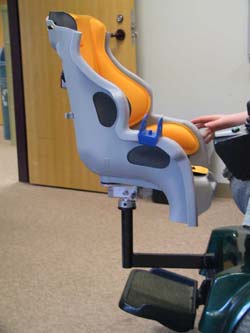 |
EVALUATION AND DISCUSSION
In the final design, the baby seat can rotate in a 360 degree circle about its midpoint. The rotation of the seat is accomplished by having a round post on the bottom of the seat fit into a round receptacle on the mounting hardware. When rotating the baby seat, it does not hit the wheelchair cushion, even while the baby seat is in a tilted position. The seat is able to lock into a 0 degree and 20 degree tilted position. The pull pin lock for the tilting mechanism is easily accessible by the client. The overall weight of the baby seat portion is 7.5 pounds.
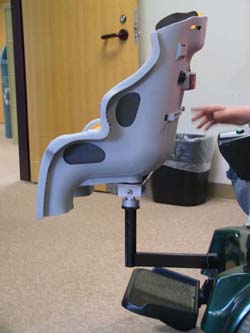 |
When the client received the final product, some minor adjustments were made to better meet her usability needs. A small amount of material was removed from the round seat bracket post to make it easier for the client to pull the seat up from the mounting hardware. Also, material was removed from the sides of the steel block that fits into the footplate receptacle so that the mounting hardware could more effortlessly be removed from the wheelchair.
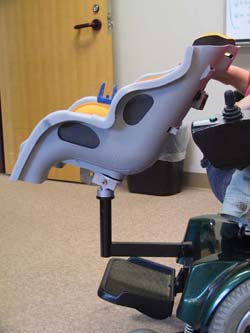 |
The client notes that the new baby seat works well for her. She uses it daily to transport her son from place to place. The client and the baby are readily able to go out to restaurants, shopping areas, day care, and other such destinations together during daily activities. She remarks that the new seat is much lighter than the original infant carrier. Another feature the client enjoys is that the baby seat is at the perfect height for going up against most tables where the baby can eat or do other activities at the table. According to the client, the baby likes to ride facing forward, as in a stroller, during travel so he can see the environment in front of him.
[You may also view a video of the baby seat.]
ACKOWLEDGMENTS
I would very much like to thank Mark McCartney for his time and expertise design and machining advice given in assistance for this project. I would also like to thank Mark Schmeler for his input and the Center for Assistive Technology for providing materials and tools.
REFERENCES
- Pride Mobility Products, Corp. <http://www.pridemobility.com/home.html>
- Topeak, Todson, Inc. <http://www.topeak.com/cgi-bin/SoftCart.exe/Store/babysitter.html?L+scstore+mvxk8405ff3d413d+1069255466>
Beth Ann Kaminski,
Human Engineering Research Laboratories,
VA Pittsburgh Healthcare System
7180 Highland Drive Building
4,
2 nd Floor, East Wing, 151R-1
Pittsburgh, PA 15206
412-365-4850,
412-365-4858 (fax),
bak1@pitt.edu
